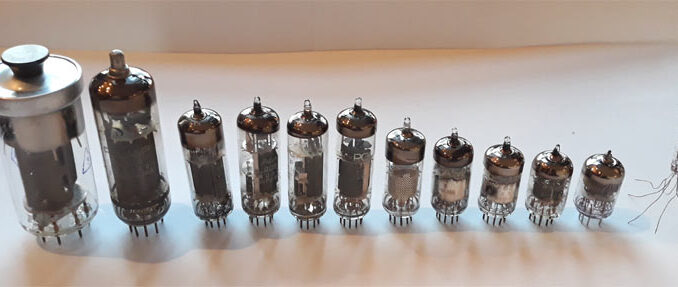
A vacuum tube, electron tube, valve (British usage), or tube (North American usage), is a device that controls the passage of electric current in a high vacuum between electrodes with an electric potential difference.
A thermionic tube or thermionic valve uses thermionic electron emission from a hot cathode to perform fundamental electronic activities such as signal amplification and current rectification. Non-thermionic versions, such as a vacuum phototube, achieve electron emission via the photoelectric effect and are employed for things like detecting light intensities. The electric field in the tube accelerates electrons from the cathode to the anode in both forms.
The diode (Fleming valve), developed in 1904 by John Ambrose Fleming, is the most basic vacuum tube, consisting of merely a heated electron-emitting cathode and an anode. Electrons can only pass from the cathode to the anode through the gadget. The addition of one or more control grids within the tube allows the voltage on the grids to control the current between the cathode and anode.
For the first part of the twentieth century, these devices were essential components of electronic circuits. Radio, television, radar, sound recording and reproduction, long-distance telephone networks, and analog and early digital computers all benefited from their development.
Although earlier technologies, such as the spark gap transmitter for radio or mechanical computers for computing, were employed in some applications, it was the advent of the thermionic vacuum tube that made these technologies widespread and practicable and formed the field of electronics.
The advent of semiconductor devices in the 1940s enabled the production of solid-state devices that are smaller, more efficient, dependable, durable, safer, and more economical than thermionic tubes. The transistor began to supplant thermionic tubes in the mid-1960s. However, until the early twenty-first century, the cathode-ray tube (CRT) served as the foundation for television displays and oscilloscopes.
Thermionic tubes are still employed in some applications, such as microwave oven magnetrons, some high-frequency amplifiers, amplifiers for electric musical instruments such as guitars, and high-end audio amplifiers, which many audiophiles prefer for their “warmer” tube sound. Vacuum tubes are not always used in electrical circuits. Gas-filled tubes are similar devices, but they contain gas, usually at low pressure, and they utilize processes linked to electric discharge in gases without the use of a heater.
Table of Contents
Classifications
Vacuum tube radio station signal generator
The number of active electrodes is one way to categorize thermionic vacuum tubes. A diode is a device with two active components that are typically used for rectification. Triodes are three-element devices used for amplification and switching. Additional electrodes provide tetrodes, pentodes, and so on, which have numerous additional functions enabled by the additional adjustable electrodes.
Other classifications are as follows:
based on frequency range (audio, radio, VHF, UHF, microwave)
- based on power rating (small-signal, audio power, high-power radio transmitting)
- according to cathode/filament type (indirectly or directly heated) and warm-up time (including “bright-emitter” or “dull-emitter”)
- design of distinctive curves (e.g., sharp- versus remote-cutoff in some pentodes)
- using the application (receiving tubes, transmitting tubes, amplifying or switching, rectification, mixing)
- specific parameters (long life, very low microphonic sensitivity and low-noise audio amplification, rugged or military versions)
- specific duties (light or radiation detectors, video imaging tubes)
- tubes for displaying information (“magic eye” tubes, vacuum fluorescent displays, CRTs).
Cathode-ray tubes, which generate an electron beam for display (such as the television image tube), as well as more specialised functions such as electron microscopy and electron beam lithography, are examples of tubes. X-ray tubes are vacuum tubes as well. Phototubes and photomultipliers rely on electron flow through a vacuum, but electron emission from the cathode is dependent on photon energy rather than thermionic emission. These “vacuum tubes” are described elsewhere since they serve purposes other than electrical amplification and rectification.
Description
Electrons from the hot cathode flow towards the positive anode, but not the other way around.
The voltage applied to the grid controls the current in the plate (anode).
A vacuum tube is made up of two or more electrodes that are held in a vacuum inside an impermeable envelope. Although ceramic and metal envelopes (atop insulating bases) have been utilised, most tubes feature glass envelopes with a glass-to-metal seal based on kovar sealable borosilicate glasses. The electrodes are connected to leads that pass through an airtight seal in the envelope. Because most vacuum tubes have a limited lifespan due to the filament or heater burning out or other failure factors, they are designed as replaceable units; the electrode leads to connect to pins on the tube’s base that fit into a tube socket.
Tubes were a common source of failure in electronic equipment, and consumers were expected to be able to replace tubes on their own. Aside from the base terminals, some tubes contained an electrode that terminated at the top cap. The main purpose for doing so was to reduce leakage resistance through the tube base, which was especially important for the high-impedance grid input. In most cases, the bases were built using phenolic insulation, which works poorly as an insulator in humid environments. Another rationale to use a top cap is to increase stability by lowering grid-to-anode capacitance,[9] improve high-frequency performance, keep a very high plate voltage away from lesser voltages, and accommodate one extra electrode than the base allows. There was even the odd design with two cap connections.

Leave a Reply